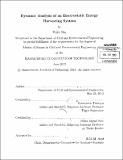Dynamic analysis of an electrostatic energy harvesting system
Author(s)
Niu, Feifei
DownloadFull printable version (11.55Mb)
Alternative title
Dynamic analysis of a nonlinear electrostatic energy harvesting system
Other Contributors
Massachusetts Institute of Technology. Department of Civil and Environmental Engineering.
Advisor
Konstantin Turitsyn.
Terms of use
Metadata
Show full item recordAbstract
Traditional small-scale vibration energy harvesters have typically low efficiency of energy harvesting from low frequency vibrations. Several recent studies have indicated that introduction of nonlinearity can significantly improve the efficiency of such systems. Motivated by these observations we have studied the nonlinear electrostatic energy harvester using a combination of analytical and numerical approaches. The analytical approach was based on the normal vibration mode analysis around an equilibrium point. The numerical model was implemented and tested using Modelica language. It was found that the efficiency of energy transfer strongly depends on three parameters: the ratio between the maximal electrical and mechanical energies in the system and ratio of natural frequencies of electric and mechanical modes, and finally the dimensionless degree of nonlinearity in the system. The dependence of the transfer factor on these three parameters was studied and characterized both theoretically and numerically. It was found that the transfer factor Tr has a sharply pronounced peak as a function of e providing a possibility of efficient energy conversion between modes with highly different normal frequencies.
Description
Thesis (S.M.)--Massachusetts Institute of Technology, Department of Civil and Environmental Engineering, 2013. Cataloged from PDF version of thesis. Includes bibliographical references (pages 97-99).
Date issued
2013Department
Massachusetts Institute of Technology. Department of Civil and Environmental EngineeringPublisher
Massachusetts Institute of Technology
Keywords
Civil and Environmental Engineering.